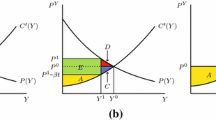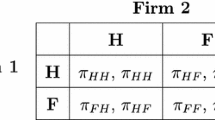Abstract
This paper studies the effects of effluent taxes on firms’ allocation of resources to cost-reducing and emission-reducing R&D, and on entrepreneurs’ decisions to develop new goods and enter the market. A tax set at an exogenous rate that does not depend on the state of technology reduces growth, the level of consumption of each good, and raises the number of firms. The induced increase in the variety of goods is a benefit not considered in previous analyses. In terms of environmental benefits, the tax induces a positive rate of pollution abatement that offsets the “dirty” side of economic growth. A tax set at an endogenous rate that holds constant the tax burden per unit of output, in contrast, has ambiguous effects on growth, the scale of activity of each firm and the number of firms. Besides being novel, the potential positive growth effect of this type of effluent tax is precisely what makes this instrument effective for welfare-maximizing purposes. The socially optimal policy, in fact, requires the tax burden per unit of output to equal the marginal rate of substitution between the growth rate of consumption and abatement. Moreover, a tax/subsidy on entry is needed, depending on whether the contribution of product variety to pollution dominates consumers’ love of variety.
Similar content being viewed by others
References
Aghion P, Howitt P (1998). Endogenous growth theory. MIT University Press, Cambridge, MA
Aghion P, Howitt P (2005). Growth with quality-improving innovations: an integrated framework. In: Aghion P, Durlauf S (eds) Handbook of economic growth, pp. North Holland, Amsterdam
Baldwin W, Scott J (1987). Market structure and technological change. Harwood Academy, New York
Bolin B (2003). Geophysical and geochemical aspects of environmental regulation. In: Maler K, Vincent J (eds) Handbook of environmental economics, pp. North Holland, Amsterdam
Brock W, Taylor M (2005). Economic growth and the environment: a review of theory and the empirics. In: Aghion P, Durlauf S (eds) Handbook of economic growth, pp. North Holland, Amsterdam
Carlton D, Loury G (1980). The limitation of Pigouvian taxes as a long-run remedy for externalities. Q J Econ 95: 559–566
Carlton D, Loury G (1986). The limitation of Pigouvian taxes as a long-run remedy for externalities: an extension of results. Q J Econ 101: 631–634
Coehen W, Levin R (1989). Empirical studies of market structure and innovation. In: Schmalensee R, Willig R (eds) Handbook of industrial organization, pp. North Holland, Amsterdam
Goulder L, Schneider S (1999). Induced technical change and the attractiveness of CO 2 emissions abatement policies. Resour Energy Econ 21: 211–253
Grimaud A (1999). Pollution permits and sustainable development in a Schumpeterian growth model. J Environ Econ Manage 38: 249–266
Helfand G, Berck P, Maull T (2003). The theory of pollution policy. In: Maler K, Vincent J (eds) Handbook of environmental economics, pp. North Holland, Amsterdam
Jaffe A, Peterson S, Portney P, Stavins R (1995). Environmental regulation and the competitiveness of US manufacturing. J Econ Lit 33: 132–163
Jaffe A, Newell R, Stavins R (2003). Technological change and the environment. In: Maler K, Vincent J (eds) Handbook of environmental economics, pp. North-Holland, Amsterdam
Joskow P, Schmalensee R, Bailey E (1998). The market for sulfur dioxide emissions. Am Econ Rev 88: 669–685
Lange A, Requate T (1999). Emission taxes for price setting firms: differentiated commodities and monopolistic competition. In: Petrakis E, Sartzetakis E, Xepapadeas A (eds) Environmental regulation and market power, pp. Edward Elgar, Celthenham
Palmer K, Oates W, Portney P (1995). Tightening environmental standards: the benefit-cost or the No-cost paradigm?. J Econ Perspect 9: 119–132
Peretto P (1996). Sunk costs, market structure and growth. Int Econ Rev 37: 895–923
Peretto P (1998). Technological change and population growth. J Econ Growth 3: 283–311
Peretto P (1999). Cost reduction, entry and the interdependence of market structure and economic growth. J Monetary Econ 43: 173–195
Petrakis E, Sartzetakis E, Xepapadeas A (eds) (1999) Environmental regulation and market power. Edward Elgar, Celthenham
Porter M (1991). America’s green strategy. Scientific Am 264: 168
Porter M, van der Linde C (1995). Toward a new conception of the environment-competitiveness relationship. J Econ Perspect 9: 97–118
Romer P (1990). Endogenous technological change. J Polit Econ 98: S71–S102
Schmalensee R, Joskow P, Ellerman D, Montero J, Bailey E (1998). An interim evaluation of sulfur dioxide emission trading. J Econ Perspect 12: 53–68
Smith VK, Walsh R (2000). Do painless environmental policies exist?. J Risk Uncertainty 21: 73–94
Smulders S, van de Klundert T (1995). Imperfect competition, concentration and growth with firm-specific R&D. Eur Econ Rev 39: 139–160
Smulders S (2000) Economic growth and environmental quality. In: Folmer H, Gabel LPrinciples of Environmental Economics. Edward Elgar, Celthenham
Spulber D (1985). Efficient regulation and long-run optimality. J Environ Econ Manage 12: 103–116
Stavins R (1998). What can we learn from the grand policy experiments? Lessons from SO 2 allowances trading. J Econ Perspect 12: 69–88
Sutton J (1991). Sunk costs and market structure. MIT University Press, Cambridge, MA
Thompson P (2001). The microeconomics of an R&D-based model of endogenous growth. J Econ Growth 6: 263–283
Author information
Authors and Affiliations
Corresponding author
Rights and permissions
About this article
Cite this article
Peretto, P.F. Effluent taxes, market structure, and the rate and direction of endogenous technological change. Environ Resource Econ 39, 113–138 (2008). https://doi.org/10.1007/s10640-007-9101-z
Received:
Accepted:
Published:
Issue Date:
DOI: https://doi.org/10.1007/s10640-007-9101-z




